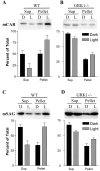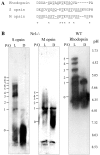GRK1-dependent phosphorylation of S and M opsins and their binding to cone arrestin during cone phototransduction in the mouse retina
- PMID: 12853434
- PMCID: PMC6740345
- DOI: 10.1523/JNEUROSCI.23-14-06152.2003
GRK1-dependent phosphorylation of S and M opsins and their binding to cone arrestin during cone phototransduction in the mouse retina
Abstract
The shutoff mechanisms of the rod visual transduction cascade involve G-protein-coupled receptor (GPCR) kinase 1 (GRK1) phosphorylation of light-activated rhodopsin (R*) followed by rod arrestin binding. Deactivation of the cone phototransduction cascade in the mammalian retina is delineated poorly. In this study we sought to explore the potential mechanisms underlying the quenching of the phototransduction cascade in cone photoreceptors by using mouse models lacking rods and/or GRK1. Using the "pure-cone" retinas of the neural retina leucine zipper (Nrl) knock-out (KO, -/-) mice (Mears et al., 2001), we have demonstrated the light-dependent, multi-site phosphorylation of both S and M cone opsins by in situ phosphorylation and isoelectric focusing. Immunoprecipitation with affinity-purified polyclonal antibodies against either mouse cone arrestin (mCAR) or mouse S and M cone opsins revealed specific binding of mCAR to light-activated, phosphorylated cone opsins. To elucidate the potential role of GRK1 in cone opsin phosphorylation, we created Nrl and Grk1 double knock-out (Nrl-/-Grk1-/-) mice by crossing the Nrl-/- mice with Grk1-/- mice (Chen et al., 1999). We found that, in the retina of these mice, the light-activated cone opsins were neither phosphorylated nor bound with mCAR. Our results demonstrate, for the first time in a mammalian species, that cone opsins are phosphorylated and that CAR binds to phosphorylated cone opsins after light activation.
Figures








Similar articles
-
Mouse cone arrestin expression pattern: light induced translocation in cone photoreceptors.Mol Vis. 2002 Dec 11;8:462-71. Mol Vis. 2002. PMID: 12486395
-
Photoreceptors of Nrl -/- mice coexpress functional S- and M-cone opsins having distinct inactivation mechanisms.J Gen Physiol. 2005 Mar;125(3):287-304. doi: 10.1085/jgp.200409208. J Gen Physiol. 2005. PMID: 15738050 Free PMC article.
-
Species-specific differences in expression of G-protein-coupled receptor kinase (GRK) 7 and GRK1 in mammalian cone photoreceptor cells: implications for cone cell phototransduction.J Neurosci. 2001 Dec 1;21(23):9175-84. doi: 10.1523/JNEUROSCI.21-23-09175.2001. J Neurosci. 2001. PMID: 11717351 Free PMC article.
-
A model for transport of membrane-associated phototransduction polypeptides in rod and cone photoreceptor inner segments.Vision Res. 2008 Feb;48(3):442-52. doi: 10.1016/j.visres.2007.08.020. Epub 2007 Oct 18. Vision Res. 2008. PMID: 17949773 Free PMC article. Review.
-
Transduction mechanisms of vertebrate and invertebrate photoreceptors.J Biol Chem. 1994 May 20;269(20):14329-32. J Biol Chem. 1994. PMID: 8182033 Review. No abstract available.
Cited by
-
Ablation of the X-linked retinitis pigmentosa 2 (Rp2) gene in mice results in opsin mislocalization and photoreceptor degeneration.Invest Ophthalmol Vis Sci. 2013 Jul 2;54(7):4503-11. doi: 10.1167/iovs.13-12140. Invest Ophthalmol Vis Sci. 2013. PMID: 23745007 Free PMC article.
-
Murine bilateral retinoblastoma exhibiting rapid-onset, metastatic progression and N-myc gene amplification.EMBO J. 2007 Feb 7;26(3):784-94. doi: 10.1038/sj.emboj.7601515. Epub 2007 Jan 18. EMBO J. 2007. PMID: 17235288 Free PMC article.
-
Native cone photoreceptor cyclic nucleotide-gated channel is a heterotetrameric complex comprising both CNGA3 and CNGB3: a study using the cone-dominant retina of Nrl-/- mice.J Neurochem. 2008 Sep;106(5):2042-55. doi: 10.1111/j.1471-4159.2008.05548.x. Epub 2008 Jul 4. J Neurochem. 2008. PMID: 18665891 Free PMC article.
-
Effect of Rds abundance on cone outer segment morphogenesis, photoreceptor gene expression, and outer limiting membrane integrity.J Comp Neurol. 2007 Oct 20;504(6):619-30. doi: 10.1002/cne.21476. J Comp Neurol. 2007. PMID: 17722028 Free PMC article.
-
Differences in RDS trafficking, assembly and function in cones versus rods: insights from studies of C150S-RDS.Hum Mol Genet. 2010 Dec 15;19(24):4799-812. doi: 10.1093/hmg/ddq410. Epub 2010 Sep 21. Hum Mol Genet. 2010. PMID: 20858597 Free PMC article.
References
-
- Abdulaeva G, Hargrave PA, Smith WC ( 1995) The sequence of arrestins from rod and cone photoreceptors in the frogs Rana catesbeiana and Rana pipiens Localization of gene transcripts by reverse-transcription polymerase chain reaction on isolated photoreceptors. Eur J Biochem 234: 437–442. - PubMed
-
- Arshavsky V, Antoch MP, Philippov PP ( 1987) On the role of transducin GTPase in the quenching of a phosphodiesterase cascade of vision. FEBS Lett 224: 19–22. - PubMed
-
- Baylor DA, Burns ME ( 1998) Control of rhodopsin activity in vision. Eye 12: 521–525. - PubMed
Publication types
MeSH terms
Substances
Grants and funding
LinkOut - more resources
Full Text Sources
Other Literature Sources
Molecular Biology Databases
Research Materials
